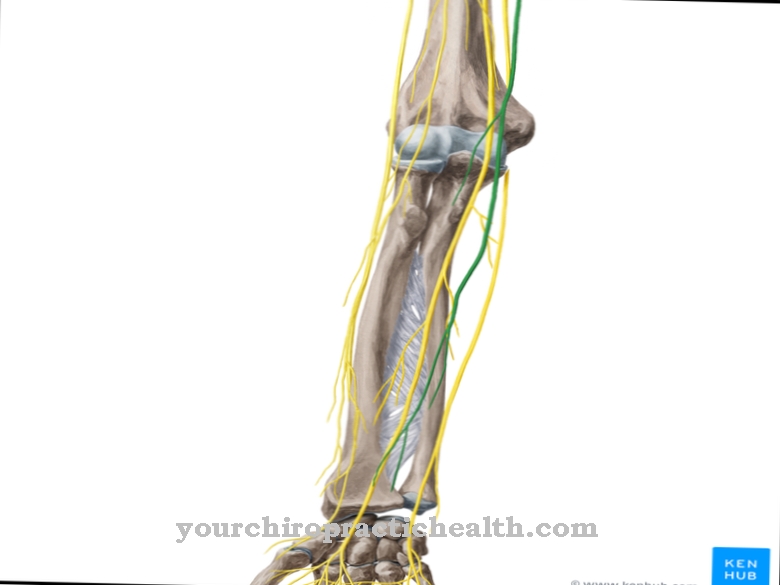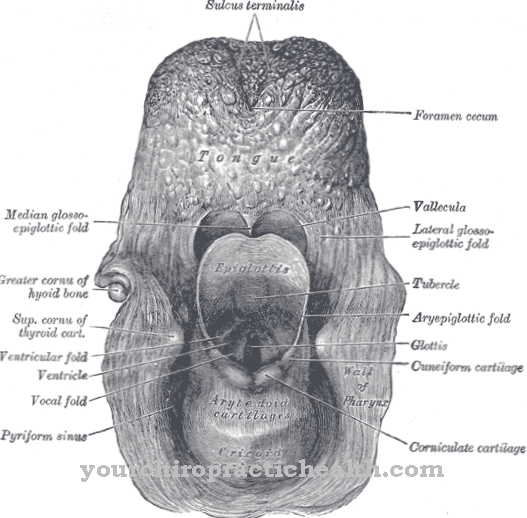The pineal gland is a small endocrine gland in the brain that mainly controls the circadian rhythm, i.e. the sleep-wake rhythm of the body via the hormone melatonin and serotonin alternately. The pineal gland is of enormous importance because it not only controls many body functions depending on the time of day, but the hormonal interplay also has an enormous impact on the psyche.
What is the pineal gland?
The pineal gland (Glandula pinealis), also Epiphysis called, is a small, approx. 5 - 8 mm long and 3 to 5 mm thick endocrine gland, which in appearance is reminiscent of small pine cones or tiny pine cones. The pineal gland lies directly on the epithalamus and controls the circadian rhythm via the synthesis of melatonin during the night in the dark.Melatonin is synthesized from serotonin in the pineal gland during tryptophan metabolism and released into the blood. Exposure to light stops melatonin production. During the deep sleep phases, which are also controlled by melatonin, the alpha cells of the anterior pituitary gland (HVL) are stimulated to release the growth hormone somatropin (also known as somatotropin).
The day-wake rhythm controlled by melatonin has a great influence on many organ functions, including the course of the puberty phase, which can set in too early if the circadian rhythm is disturbed, with the consequence of sexual prematurity or completely delaying or hindering sexual maturation.
Anatomy & tasks
The pineal gland is a small endocrine gland in the diencephalon, directly attached to the epithalamus. The pineal gland consists mainly of secretory cells (pinealocytes), which release the hormone melatonin into the bloodstream in the dark, and glial cells, which have a certain support function and provide electrical insulation between the nerve cells.
In addition to melatonin, the gland also releases neuropeptides, the effects of which are still largely unexplored. The pineal gland shows the first signs of calcification at the age of less than 20 years. Glial cells multiply and glandular tissue is broken down. Small cysts form in which calcium and magnesium salts are deposited and form small plaques.
Medically, the plaques that are visible in the X-ray are referred to as brain sand or acervulus. The importance of brain sand has not yet been conclusively researched. Since the pineal gland aligns the circadian rhythm, among other things, according to the incidence of light, evolution had to create a device that informs it about the currently prevailing light conditions.
The pineal gland receives light signals first from the retina via the optic nerve into the Nucleus suprachiasmaticus in the hypothalamus and from there to the spinal cord. Via further nodes they run again towards the brain to the pineal gland.Function & tasks
In addition to the suprachiasmatic nucleus in the hypothalamus, which is the primary center for chronobiological processes in the body, the pineal gland has the task of synchronizing the day-night rhythm, so to speak "fine-tuning" it. Depending on the incidence of light in the eyes, it adapts the genetically pre-programmed circadian rhythm, which can vary up or down by 24 hours, to the actual day-night conditions.
The neurotransmitter melatonin has a wide-ranging effect on the function of many organs, the activity of which is controlled accordingly. For example, kidney function, heart rate, blood pressure, body temperature and many other organ activities are controlled via the neurotransmitter. Melatonin stimulates the release of FSH (follicle-stimulating hormone) and LH (luteinizing hormone) in women.
Both hormones promote the maturation of eggs in the ovaries and in men the hormones promote sperm production and sperm maturation in the testicles. Hormone production reaches a peak at night - between two and three o'clock - and then rapidly drops again as soon as light comes in through the eyes, whereby the closed eyes perceive the light and “report” it to the pineal gland.
The mechanism also works for the blind. The function of the pineal gland as a synchronizer of the circadian rhythm is particularly important when the time zones change, e.g. B. for long-haul flights in east-west or west-east direction.
You can find your medication here
➔ Medication for sleep disordersIllnesses & ailments
Diseases and symptoms associated with the pineal gland can affect the endocrine tissue of the gland itself, or it can be benign or malignant tumors that are in close proximity to the gland and due to the physical pressure it exerts on the surrounding area Exercise tissue, cause symptoms.
The so-called pineal cysts are relatively common among the tumors associated with the pineal gland, which occur rarely. These are benign cysts that arise from the pineal gland and are often accompanied by symptoms such as headache, nausea, visual disturbances or even impaired balance.
With the appropriate size, they can lead to a build-up of cerebrospinal fluid, which can cause the formation of a hydrocephalus. Pineal cysts usually appear in children to early adulthood and can be made visible on magnetic resonance imaging. A very rare tumor that originates directly from the melatonin-producing cells of the pineal gland, the parenchymal cells, is pineal globlastoma.
It is a malignant tumor that causes symptoms of increased intracranial pressure at an early stage. More often, tumors in the pineal gland are germ cell tumors, which are almost always benign in women and more malignant in men. It has not yet been conclusively researched which triggering factors are responsible for the development of the tumors.
In recent years, research projects have found indications for a certain genetic disposition. Defined gene mutations seem to be at least possible trigger factors.


























